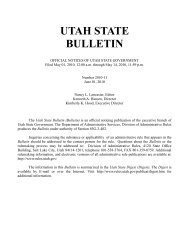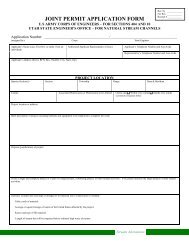Vol. 2007, No. 15 (08/01/2007) PDF - Administrative Rules - Utah.gov
Vol. 2007, No. 15 (08/01/2007) PDF - Administrative Rules - Utah.gov
Vol. 2007, No. 15 (08/01/2007) PDF - Administrative Rules - Utah.gov
Create successful ePaper yourself
Turn your PDF publications into a flip-book with our unique Google optimized e-Paper software.
DAR File <strong>No</strong>. 3<strong>01</strong>80<br />
NOTICES OF PROPOSED RULES<br />
(4)(a) A staff-directed time-out or a self-directed time-out is<br />
only used when a client's behavior is disruptive to a client's ability to<br />
participate in the activity, or as an intervention when the client poses<br />
a risk of harm to a person or property.<br />
(b) A time out shall not be used to coerce, punish, or retaliate<br />
against a client.<br />
(c) A staff-directed time-out shall be documented in an<br />
incident report.<br />
(d) If a client is placed in a staff-directed time-out more than<br />
four times in any twenty-four hour period, a review is conducted by<br />
the mental health therapist, medical practitioner, or a behavior<br />
consultant in a program that is under exclusive contract with DSPD<br />
and provides services only to DSPD clients, to determine the<br />
suitability of the client remaining in the program.<br />
(e) Any one time-out shall not exceed 30 minutes in duration<br />
unless a mental health therapist, a medical practitioner, or a behavior<br />
consultant in a program that is under exclusive contract with DSPD<br />
and provides services only to DSPD clients, remains present on site,<br />
evaluates the client, and determines that the time-out remains<br />
necessary.<br />
(f) A staff who is responsible for monitoring a client in a staffdirected<br />
time-out shall have no other immediate responsibilities and<br />
is required to maintain continuous visual or auditory contact with a<br />
client.<br />
(5)(a) Seclusion may only be used when a client's behavior is<br />
disruptive to a client's ability to participate in the activity, or as an<br />
intervention when the client poses a high risk of harm to a person or<br />
property, and a less restrictive method of behavior management is<br />
ineffective.<br />
(b) Seclusion shall not be used to discipline, coerce, punish, or<br />
retaliate against a client.<br />
(c) Seclusion shall be documented in an incident report.<br />
(d) If a client is placed in seclusion more than 2 times in any<br />
twenty-four hour period, a review is conducted by a mental health<br />
therapist, a medical practitioner, or a behavior consultant in a<br />
program that is under exclusive contract with DSPD and provides<br />
services only to DSPD clients, to determine the suitability of the<br />
client remaining in the program.<br />
(e) Any one seclusion shall not exceed the time required for<br />
the client to gain control of the client's emotions and actions, and in<br />
no event shall the seclusion exceed 2 hours in duration unless a<br />
mental health therapist, a medical practitioner, or a behavior<br />
consultant in a program that is under exclusive contract with DSPD<br />
and provides services only to DSPD clients, remains present on site,<br />
evaluates the client, and determines that the seclusion remains<br />
necessary.<br />
(f) A staff who is responsible for monitoring a client in<br />
seclusion shall have no other immediate responsibilities and is<br />
required to maintain continuous visual and auditory contact with a<br />
client.<br />
(g) Seclusion shall not be used in any:<br />
(i) therapeutic school, or<br />
(ii) non-residential program.<br />
(6) If there is any type of emergency, such as a fire alarm or<br />
evacuation notification, clients in time-out or seclusion shall<br />
immediately be released and follow the safety plan.<br />
(7) A client who is placed in a staff-directed time-out or<br />
seclusion shall not be in possession of potentially harmful objects or<br />
materials, such as articles of clothing that could present a risk or<br />
harm.<br />
(a) A client who has expressed any suicidal or self-harm<br />
ideation or behavior shall be visually monitored by staff until a<br />
mental health therapist evaluates the client and makes further<br />
recommendations.<br />
(b) A client in time-out or seclusion shall be provided with<br />
clothing that preserves the comfort, modesty, and dignity of the<br />
client.<br />
(8) Toilet facilities shall be provided for a client who is in<br />
time-out or seclusion.<br />
(9)(a) Time-out rooms shall not be located in closets,<br />
bathrooms, unfinished basements, unfinished attics, or boxes.<br />
(b) Seclusion rooms shall not be located in closets, bathrooms,<br />
bedrooms, unfinished basements, unfinished attics, or boxes.<br />
(c) A seclusion room shall be unfurnished and shall contain no<br />
equipment or materials that a client may use to inflict harm upon any<br />
person or property.<br />
(d) A room used for time-out or seclusion shall be wide<br />
enough and deep enough to allow the client to lie prone with arms<br />
extended without touching the walls, with a ceiling height of at least<br />
7 feet.<br />
(e) A room used for time-out or seclusion shall have either<br />
natural or mechanical ventilation, and shall be maintained at no less<br />
than 65 degrees and no more than 80 degrees.<br />
(f) A room used for seclusion shall be equipped with a break<br />
resistant window or camera that allows for full observation of all<br />
areas of the room.<br />
(g) A room used for time-outs or seclusion shall not have<br />
locking capability, except:<br />
(i) after receiving the prior written approval of the Office of<br />
Licensing, a program may equip a time-out or seclusion room with a<br />
magnetic lock that is connected with the program's alarm system and<br />
that automatically unlocks in the event of an emergency; and<br />
(ii) after receiving the prior written approval of the fire<br />
marshal, a program may use a magnetic lock in a time-out or<br />
seclusion room that is connected with the program's alarm system<br />
and that automatically unlocks in the event of an emergency.<br />
(10) The program's mental health therapist shall be responsible<br />
for the supervision of the program's behavior management<br />
procedures.<br />
(a) A program that is under exclusive contract with DSPD and<br />
provides services only to DSPD clients may utilize the services of a<br />
"behavior consultant" instead of a mental health therapist.<br />
R5<strong>01</strong>-2-10. Rights of Clients.<br />
(1) The program policies and procedures shall describe clients'<br />
rights, which shall include but not be limited to:<br />
(a) the right to confidentiality of information about<br />
prospective, current and former clients, and the right to<br />
confidentiality of records concerning prospective, current and<br />
former clients, except when disclosure is required by law or<br />
requested by the client's guardian or an adult client;<br />
(b) the right to receive medical care, treatment services,<br />
nutritious food, and in residential programs, clean clothing and safe<br />
shelter;<br />
(c) the right to be informed of the reasons for an involuntary<br />
termination, appeals processes in programs that permit appeals of<br />
involuntary terminations, and the criteria for re-admission to the<br />
program in programs that permit readmission;<br />
(d) the right to be treated with courtesy and professionalism by<br />
staff;<br />
UTAH STATE BULLETIN, August 1, <strong>2007</strong>, <strong>Vol</strong>. <strong>2007</strong>, <strong>No</strong>. <strong>15</strong> 37



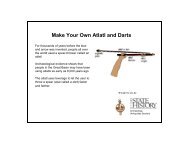

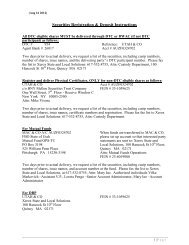
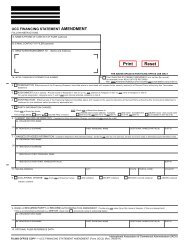
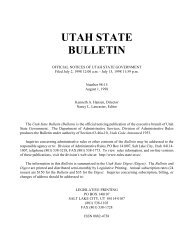
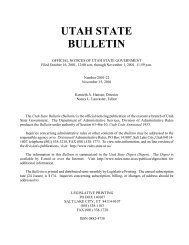



![Lynx avoidance [PDF] - Wisconsin Department of Natural Resources](https://img.yumpu.com/41279089/1/159x260/lynx-avoidance-pdf-wisconsin-department-of-natural-resources.jpg?quality=85)
